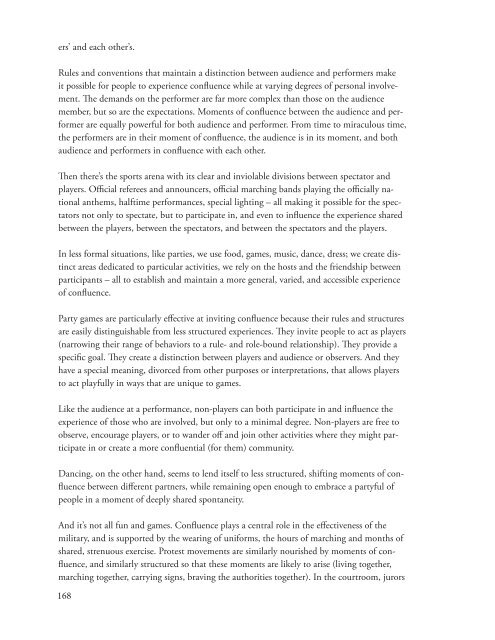A-Playful-Path_DeKoven-web
A-Playful-Path_DeKoven-web
A-Playful-Path_DeKoven-web
Create successful ePaper yourself
Turn your PDF publications into a flip-book with our unique Google optimized e-Paper software.
ers’ and each other’s.<br />
Rules and conventions that maintain a distinction between audience and performers make<br />
it possible for people to experience confluence while at varying degrees of personal involvement.<br />
The demands on the performer are far more complex than those on the audience<br />
member, but so are the expectations. Moments of confluence between the audience and performer<br />
are equally powerful for both audience and performer. From time to miraculous time,<br />
the performers are in their moment of confluence, the audience is in its moment, and both<br />
audience and performers in confluence with each other.<br />
Then there’s the sports arena with its clear and inviolable divisions between spectator and<br />
players. Official referees and announcers, official marching bands playing the officially national<br />
anthems, halftime performances, special lighting – all making it possible for the spectators<br />
not only to spectate, but to participate in, and even to influence the experience shared<br />
between the players, between the spectators, and between the spectators and the players.<br />
In less formal situations, like parties, we use food, games, music, dance, dress; we create distinct<br />
areas dedicated to particular activities, we rely on the hosts and the friendship between<br />
participants – all to establish and maintain a more general, varied, and accessible experience<br />
of confluence.<br />
Party games are particularly effective at inviting confluence because their rules and structures<br />
are easily distinguishable from less structured experiences. They invite people to act as players<br />
(narrowing their range of behaviors to a rule- and role-bound relationship). They provide a<br />
specific goal. They create a distinction between players and audience or observers. And they<br />
have a special meaning, divorced from other purposes or interpretations, that allows players<br />
to act playfully in ways that are unique to games.<br />
Like the audience at a performance, non-players can both participate in and influence the<br />
experience of those who are involved, but only to a minimal degree. Non-players are free to<br />
observe, encourage players, or to wander off and join other activities where they might participate<br />
in or create a more confluential (for them) community.<br />
Dancing, on the other hand, seems to lend itself to less structured, shifting moments of confluence<br />
between different partners, while remaining open enough to embrace a partyful of<br />
people in a moment of deeply shared spontaneity.<br />
And it’s not all fun and games. Confluence plays a central role in the effectiveness of the<br />
military, and is supported by the wearing of uniforms, the hours of marching and months of<br />
shared, strenuous exercise. Protest movements are similarly nourished by moments of confluence,<br />
and similarly structured so that these moments are likely to arise (living together,<br />
marching together, carrying signs, braving the authorities together). In the courtroom, jurors<br />
168


